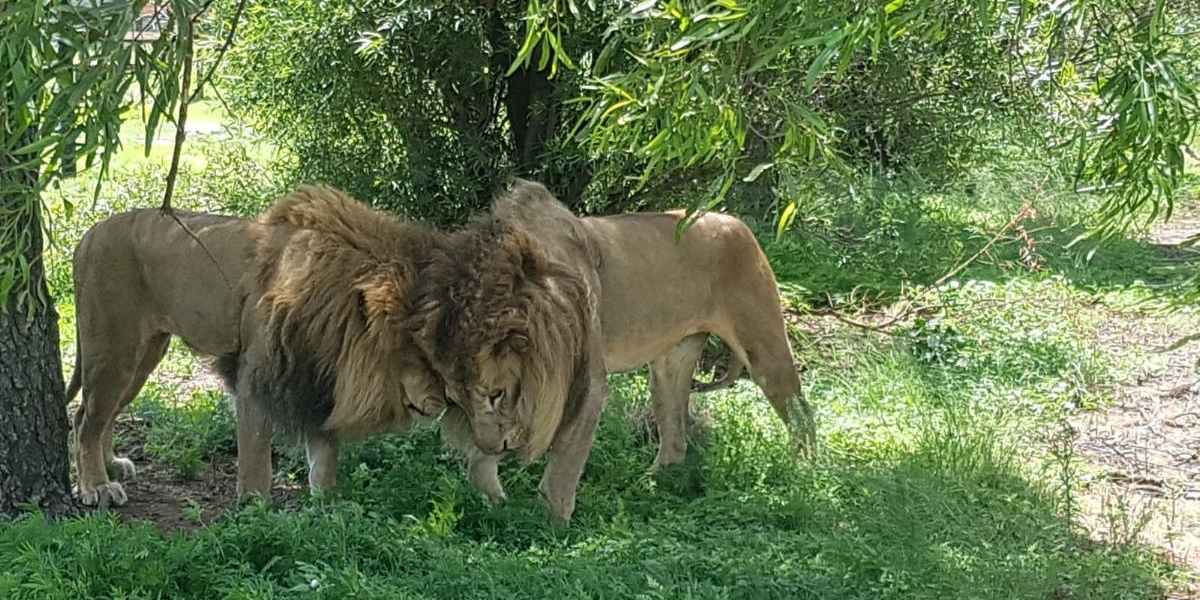
A large shipment of cat brains arrives at the U.S. Customs office. The legal forms accompanying the box of ethically-obtained research specimens? Missing a stamp. Return label: South Africa.
“They had to send the brains all the way back. I had to fly [to South Africa] and be like, where are my brains?”
Fortunately for Jessica Burkhart, neuroscientist and Ph.D. candidate with the University of Minnesota Lion Center, studying brains could wait. The shipping blunder was near the end of a long series of events that paved a path to a different kind of research.
Burkhart, who for most of her professional career studied Alzheimer’s in Alaska, decided life is too short not to do what you love. For her, that's studying lions. After joining Craig Packer’s lion research team Burkhart now conducts research full time at a lion sanctuary in South Africa. There, she administers oxytocin—the “love” hormone—to pairs of unbonded lions in hopes of encouraging positive attachment, or at the very least, peaceful co-existence. Social tolerance could make a world of difference for conservation, where rehoming, reintroduction and rehabilitation methods often involve placing lions in close quarters with one another. What started as a research detour could change the future of wildlife conservation.
Prides and Presuppositions
The key begins with lions’ “extroverted” nature.
A young male lion will eventually be ousted from his pride and forced to find a new one. But before he does, he will join forces with one (or more) other estranged males, creating affectionate, inseparable bonds that last for life. But all other species of cat are solitary, including their closest relative, the leopard.
“So I wondered, what is it about lions that makes them social? There has to be a difference in their brain structure. I have this hypothesis in my mind that lions have to have more oxytocin receptors [in their brain] than their counterparts.”
When bonded lions greet, it’s often with a big, emphatic head rub. Conflict arises, however, when social bonds are forcibly imposed on lions who are strangers to one another, as is often the case in some conservation methods, zoos and wildlife rehabilitation settings.
Two un-bonded lions placed together in a cramped habitat—or even next to each other in adjacent cages—can result in stress, injury, or death.
Their resistance to imposed bonding posed an interesting question for Burkhart. You can’t force connection—but can you aid the process? Burkhart speculated that if lions have lots of oxytocin receptors, they might elicit strong positive social responses to doses of oxytocin. This could facilitate bonding.
A roaring success
Burkhart administers oxytocin to lions by spraying it up their nostrils. All she has to do is get close to their giant, regal heads. Meat pierced on a long stick draws a lion to the edge of its enclosure. Through the fence, Burkhart has her window of opportunity.
“Oxytocin decreases amygdalar function, which means fear. It increases nucleus accumbens, so it's increasing reward. And it's increasing your connections to your prefrontal cortex, so, learning. So not only do you not feel as afraid, you're getting a social reward, but you're also learning.”
To see if lions respond to oxytocin, Burkhart first conducted a study to see if lions dosed with oxytocin would be less reactive than their counterparts when exposed to the roars of unfamiliar lions.
“We played a roar from an unfamiliar lion from the Serengeti on a big speaker, and then we measured the lions’ response. Without oxytocin, 15 lions [responded with roaring and vocalization sequences] in one trial: 48 times —and in another trial: 64 times. With oxytocin? 0.”
This gave her enough confidence to move to the next step: careful lion socializations mediated by a series of oxytocin boosts. She began with seven pairings of big cats. Some had never been introduced before, while others had a history of conflict.
By the end of the study, all seven pairings had restored relationships–with lasting effects.
Everywhere the light touches
The history of conservation in Africa is complicated and often controversial. But one thing is certain: African wilderness has all but disappeared. Fences along reserves keep animals in and people out. The conservation tool intended to reduce human-animal conflict has its downsides: one being that boundaries prevent animals from accessing wider habitats and interacting with one another. For lions, this means a higher risk of inbreeding.
“So they start pulling these animals from all over and try to create an artificial pride. They're not just gonna bond with any animal they come across, but that's the future of conservation. So what I'm doing now is introductions.”
For now, Jessica focuses her research trials on lions in sanctuaries. There, lions are accustomed to the presence of people. But the last thing Burkhart wants is to acclimate wild lions to humans, so she suggests using different methods in conservation scenarios–perhaps by administering oxytocin while the lions are sedated.
Oxytocin could be beneficial for more than lions. Her research trials included tiger pairings, but Burkhart has also tried her method with cheetahs and rhinos, both of which can die from experiencing too much stress.
Burkhart is hesitant to claim her methods as a cure-all, especially if they’re replicated without care and extensive monitoring. And she’s still working on refining the protocol. “Oxytocin is specifically for the processing of social information, which means it can also enhance negative [social information], so you have to be very careful.” But she’s hopeful about future research applications. For critically endangered species, an oxytocin intervention could be the difference between survival and extinction.
-Adara Taylor